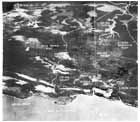 Human face of war Reconnaissance by KANEMOTO Rinzô |
Evidence from initial investigations led to a determination that native trails led to Kokoda along the Manbare and Kumusi Rivers, and that a pack-trail existed from Buna to Kokoda. Aerial reconnaissance by planes from the 25th Air Flotilla based at Rabaul on 27 and 30 June discovered what seemed to be a vehicular road between Buna and Kokoda. The following report was consequently telegraphed to related units.
There exists a 2 or 3 metre wide track along the Mambare and Kumusi rivers for approximately 5 kilometres inland, and a 1 metre wide track for a further 10 kilometres. Thereafter a road was not detected due to thick jungle.
There is a road passable by motor transport between Buna and Kokoda. There is a bridge over the Kumusi River passable by motor transport to the east of Papaki. This road is in flat terrain devoid of ravines.
Detected a prominent road winding through the rugged valleys between Kokoda and Fada (mountains north of Isurava – author’s note). Determined areas passable by motor transport and areas where difficulties would arise.
This road emerges from Fada at the summit of the mountain, and then runs west along the Waume Creek (probably the Brown River – author’s note) until it disappears in the clouds. It is judged to be a road passable by motor transport that proceeds to Port Moresby.
No other prominent roads were detected in the area.
The unit responsible for arranging vehicular supply for the South Seas Force was the 55th Regiment Supply 2nd Company. Lt KANEMOTO Rinzô, a platoon leader with the Supply Company, was dispatched as an observer on the second of these reconnaissance flights. It was his first time in a plane, and after circling over what looked like Giruwa for several minutes, he lost all sense of direction. From an altitude of one to two thousand metres, however, it was impossible to tell how wide or in what condition was the ribbon-like road that wound in and out of the jungle to the south of the proposed landing position. The appearance of several Allied P-38s, though engaged by the five escort Zero fighters, only added to KANEMOTO’s sense of confusion.
His report to HORII, the Force commander, as follows, was consequently quite unsatisfactory.
Unfortunately, I cannot report with any confidence. There is certainly a road from Giruwa. That is all I can confirm. Only after landing can it be determined if it is suitable for vehicular traffic.
After further aerial reconnaissance, 17th Army Headquarters determined that while it was essential to investigate and improve the condition of these roads, it was likely that supply for an overland force was possible.
Contributed by Steven Bullard (AJRP)
Sources
Bôeichô Bôei Kenshûjo Senshishitu (ed.), Senshi sôsho Minami Taiheiyô rikugun sakusen 1: Pôto Morusubii-Gashima shoki sakusen (Official war history South Pacific Area army operations, vol.1: Port Moresby-Guadalcanal first campaigns), Tokyo: Asagumo Shinbunsha, 1968, p. 172.
Kanemoto Rinzô, Nyûginia senki (Battles in New Guinea), Tokyo: Kawade Shobô, 1968, pp. 92–101.
Related links
 Overview
Overview Campaign text
Campaign text  Supply plan
Supply plan  Training
Training  Equipment
Equipment  Morale
Morale  KANEMOTO
KANEMOTO  TSUJI
TSUJI  SSF order of battle
SSF order of battle
Human face of war
| ||||
| ||||
| ||||
| ||||
| ||||
| ||||
Click images to enlarge.

AWM 106525

AWM 106524
The AJRP has wound up its activities at the Memorial for the moment. Please contact the relevant officer of the Australian War Memorial for assistance. Internet implementation by Fulton Technology and AJRP staff . Visit the Australian War Memorial home page. |